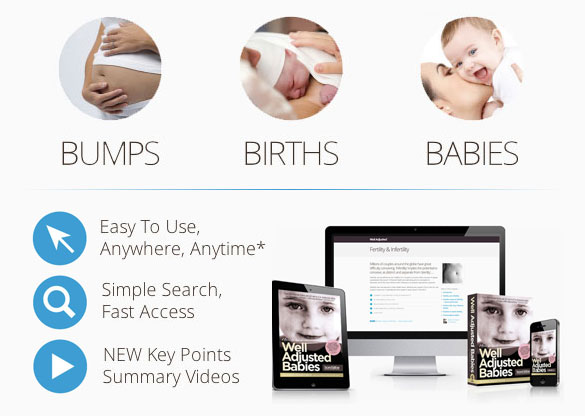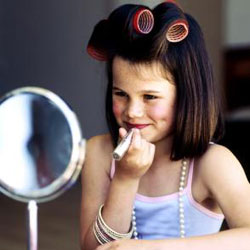 My five year old daughter came home with her face made up by her ten year old (going on twenty-five) cousin. Nothing was spared: foundation, blush, eye liner, eye shadow, lipstick as well as bright red finger and toenails — just in case I had not noticed. The only thing that was missing was a spray tan…
My five year old daughter came home with her face made up by her ten year old (going on twenty-five) cousin. Nothing was spared: foundation, blush, eye liner, eye shadow, lipstick as well as bright red finger and toenails — just in case I had not noticed. The only thing that was missing was a spray tan…
The job was impressive but then again she was a cheer leader after all and this was part of their ‘sport’. Come to think about it, the first time I wore foundation was on my wedding day thanks to the persistence of my younger and obviously more fashionable sister — how times have changed! Am I being old fashioned, or is it ok for me to be concerned that my little girl wants to look like the Barbie dolls she received for her fifth birthday?
As a parent with two young daughters, I know that I have some control over what they put on their bodies, however by their teens – thanks to peer and media pressure – there is a good chance they won’t listen to me at all (sigh)… So this provided me with a good opportunity to investigate what women put on their face, and more importantly, what alternatives are available that won’t adversely affect their health.
The cosmetic industry is largely self-regulated which can mean little or no regulation. Put simply; manufacturers can put (almost) whatever ingredients they want into their products providing they don’t make outrageous claims on the labels. Remarkably almost 80% of ingredients in personal care products have never been assessed for their impact on human health.1
The great majority of those that have been tested are skin, eye and lung irritants, as well as known carcinogens and reproductive toxins in ‘acceptable’ levels. This is probably why in 2006, the Danish government launched a preventative campaign warning pregnant women not to use cosmetics, personal care products and hair dyes2.
If you have eight minutes to spare, I suggest you watch the Story of Cosmetics (available on the internet) and you will know what I mean. Furthermore, the shift towards online shopping of overseas products has meant that the regulatory systems in place to protect the consumers are now by-passed.
Let’s examine lipstick as an example…
A recent investigation of 400 lipsticks including those marketed as ‘natural’ identified the heavy metal lead in most of them, with some containing levels up to 7.19 ppm.3 The manufacturers do not add lead to lipsticks, rather it is found naturally in the pigments mined from the ground. As there is no limit to the amount of lead permitted in lipsticks you essentially have no idea how much you could be exposed to.
There is no safe level for lead. Lead is particularly toxic to an unborn foetus as it crosses the placenta where it may affect foetal brain development causing learning and behaviourhal disorders, reduced IQ, sleep disturbances and increased aggression later in life. My advice therefore is to limited your use of tinted lipsticks – even those marketed as natural – and use non-tinted lip balms derived from vegetable, nut and seed oils.
Fragrances are another concern…
As a result of trade secrets, manufacturers are not obliged to reveal the hundreds of chemicals that make up a perfume or fragrance in their product. Apart from causing skin and lung irritation, fragrances can also disguise more sinister contaminants such as phthalates which are a family of industrial chemicals that mimic the hormone oestrogen and have been linked to birth defects and reproductive changes in children (early puberty).
According to the Environmental Working Group, 72% of personal care products tested contained phthalates.4 Not surprisingly, the American Contact Dermatitis Society in 2007 voted fragrances allergen of the year.5 Fragrances should be avoided in perfume and personal care products. A better option is to use pure essential oils sparingly.
Several preservatives to be avoided…
Whilst preservatives play an important role in preventing microbial growth in your products, there are several that should be avoided because they have been known to cause skin irritation or because they release formaldehyde. Formaldehyde is banned in personal care products in Japan and Sweden, and restricted in the European Union and Canada, however it continues to be present in products sold in Australia and the USA. Many so called ‘natural’ preservatives also work on a formaldehyde exchange system such as diazolidinyl urea and should also be avoided. A list is provided in my book – Healthy Home Healthy Family.
Despite the fact personal care products must provide full ingredient disclosure in accordance with the Trades Practices (Consumer Products Information Standards) (Cosmetics) Regulations 1991, incidental ingredients such as phthalates, formaldehyde, nitrosamines, nanoparticles and dioxins that have no technical or functional effect are not required to be listed on the label despite their adverse health effects.
Adverse health effects
Many of the ingredients found in cosmetics are associated with adverse health effects. In Australia, the regulation of chemicals in household products involves multiple organisations having limited powers that are typically slow to react to international data.6
Fortunately however there are a growing number of organisations and governmental agencies — including the REACH Directive by the European Union and the US Environmental Working Group’s Skin Deep website — recognising these hazards and providing alternatives to consumers.
. . . . .
From the desk of…
Nicole Bijlsma
Author of “Healthy Home, Healthy Family”
. . . . .
2. SBS Corporation. 2007, Men in Danger (DVD). Marcom Projects.
3. US Food and Drug Administration, 2012, Lipstick and lead: questions and answers. (Online). Available: https://www.fda.gov/cosmetics/productandingredientsafety/productinformation/ucm137224.htm
4. Environmental Working Group, 2002. Not too pretty. Phthalates, beauty products and the FDA. (Online). Available: www.safecosmetics.org/downloads/NotTooPretty_report.
5. American Contact Dermatitis Society, 2013, History of allergen of the year. (Online). Available: https://www.contactderm.org/i4a/pages/index.cfm?pageid=3467
6. National Toxics Network, 2011. Review of the National Industrial Chemicals Notification and Assessment Scheme. Department of Health and Ageing. Department of Finance and Deregulation. December 2011. (Online). Available: https://www.ntn.org.au/wp/wp-content/uploads/2012/07/NICNASsub2011-final1.pdf
P.S. Here’s a sneak peek at our NEW Well Adjusted Babies eCourse for parents and practitioners (coming soon!)…



 My five year old daughter came home with her face made up by her ten year old (going on twenty-five) cousin. Nothing was spared: foundation, blush, eye liner, eye shadow, lipstick as well as bright red finger and toenails — just in case I had not noticed. The only thing that was missing was a spray tan…
My five year old daughter came home with her face made up by her ten year old (going on twenty-five) cousin. Nothing was spared: foundation, blush, eye liner, eye shadow, lipstick as well as bright red finger and toenails — just in case I had not noticed. The only thing that was missing was a spray tan…
